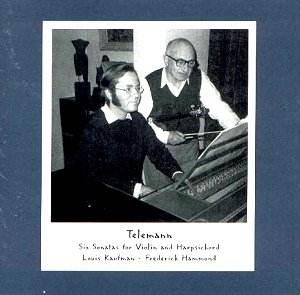Though greatly admired for his romantic affiliations
and for his unflagging commitment to the then contemporary literature
- Martinů, Wirén, Sauguet, Larsson amongst many - Louis Kaufman
(1905-1994) was a broad-minded violinist. He was the vibrant soloist
on the soundtrack of many a Fox film – Gone with the
Wind, Modern Times, For Whom the Bell Tolls.
That gloriously flamboyant tone remained with him for much of
the rest of his life, illuminating even the unlikeliest crevice
of his repertoire. Those who have heard his Delius First Sonata,
for example, will know what I mean. In this Music and Arts release,
taped towards the end of his active career, Kaufman essays Telemann
and Spohr, the former in his own edition, and they make for welcome
discmates.
Yes, the sound is rather dry and unvarnished;
it does tend to skew the aural perspective in favour of the glamorous
violin soloist and this in turn intensifies his occasional overpowering
of Frederick Hammond’s musicianly and discreet harpsichord playing.
Whether it’s the recording or Kaufman’s misjudgement his playing
is also sometimes simply too loud for optimum points of dynamic
variance to be observed – something that can be noted in the Adagio
of the Sonata in G [No. 1] – though his sheer expressivity is
never in doubt. These are in fact characterful and committed performances
that are laced with Kaufman’s brand of inflective devices to further
deepen the curve of the music – listen to the finger position
changes in the Andante of No. 1, with the discreet but assuredly
Old School portamenti as well. In the Allemande of the Sonata
in D his coiled, intense and oscillatory vibrato makes its own
distinctive mark and the concluding Gigue is bold and vigorous.
We can admire his piquant hyper-Romanticisms in the Allegro of
the Sonata in B [No. 3], especially at such a jog-trot tempo whilst
in that sonata’s concluding Vivace he really digs into the string
– there’s real relish here, a real sense of romantic phraseology
at work.
He certainly warms to the vocality of the sonata
in A and lavishes care and tonal resources on the rise and fall
of its melodic line, allowing him to inflect at will, varying
vibrato usage - colour and speed - as he does so. Kaufman was,
whatever one’s objections, a powerfully communicative musician
and the Fifth Sonata bears witness to his crisp bowing, his sensitively
employed diminuendi on certain repeated phrases - variance intensifying
interest. We can also admire Hammond’s excellent contribution,
not least to the Adagio of this sonata, where his eloquence is
palpable. In the sixth and final of the set, in A, Kaufman gives
the Corrente a delicious little kick and ends the Gigue with a
fine flourish of triumph. For the Spohr Sonata Concertante he
is joined by harpist Susann McDonald. There are plenty of lyrical
opportunities for both musicians in the first movement and in
the Larghetto they bring out every gorgeous strand. The finale
– which does rather overstay its welcome – nevertheless has a
lovely middle section to which both musicians give their considerable
and appreciable sensitivity; Kaufman is particularly vibrant and
alive.
Edited and performed by Kaufman with directness
and robustness these recordings amplify the impressions made by
his Four Seasons discs and those of L’Estro Armonico. He was an
alluring tonalist who with vibrant discretion put his expressive
potential at the service of older music.
Jonathan Woolf

